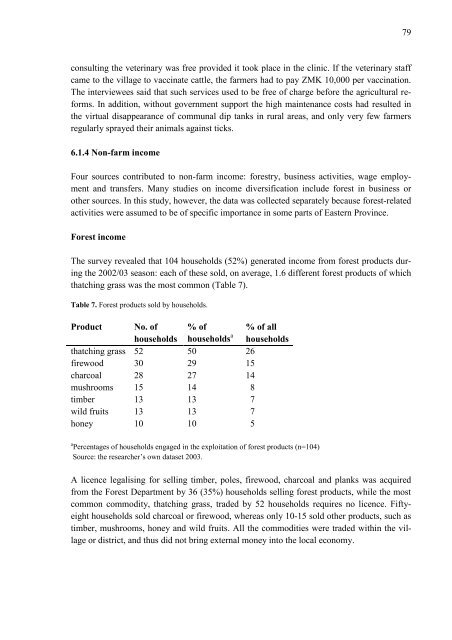Rural Income Generation and Diversification - A Case Study ... - Doria
Rural Income Generation and Diversification - A Case Study ... - Doria
Rural Income Generation and Diversification - A Case Study ... - Doria
You also want an ePaper? Increase the reach of your titles
YUMPU automatically turns print PDFs into web optimized ePapers that Google loves.
consulting the veterinary was free provided it took place in the clinic. If the veterinary staff<br />
came to the village to vaccinate cattle, the farmers had to pay ZMK 10,000 per vaccination.<br />
The interviewees said that such services used to be free of charge before the agricultural reforms.<br />
In addition, without government support the high maintenance costs had resulted in<br />
the virtual disappearance of communal dip tanks in rural areas, <strong>and</strong> only very few farmers<br />
regularly sprayed their animals against ticks.<br />
6.1.4 Non-farm income<br />
Four sources contributed to non-farm income: forestry, business activities, wage employment<br />
<strong>and</strong> transfers. Many studies on income diversification include forest in business or<br />
other sources. In this study, however, the data was collected separately because forest-related<br />
activities were assumed to be of specific importance in some parts of Eastern Province.<br />
Forest income<br />
The survey revealed that 104 households (52%) generated income from forest products during<br />
the 2002/03 season: each of these sold, on average, 1.6 different forest products of which<br />
thatching grass was the most common (Table 7).<br />
Table 7. Forest products sold by households.<br />
Product No. of % of % of all<br />
households households a households<br />
thatching grass 52 50 26<br />
firewood 30 29 15<br />
charcoal 28 27 14<br />
mushrooms 15 14 8<br />
timber 13 13 7<br />
wild fruits 13 13 7<br />
honey 10 10 5<br />
a Percentages of households engaged in the exploitation of forest products (n=104)<br />
Source: the researcher’s own dataset 2003.<br />
A licence legalising for selling timber, poles, firewood, charcoal <strong>and</strong> planks was acquired<br />
from the Forest Department by 36 (35%) households selling forest products, while the most<br />
common commodity, thatching grass, traded by 52 households requires no licence. Fiftyeight<br />
households sold charcoal or firewood, whereas only 10-15 sold other products, such as<br />
timber, mushrooms, honey <strong>and</strong> wild fruits. All the commodities were traded within the village<br />
or district, <strong>and</strong> thus did not bring external money into the local economy.<br />
79

















